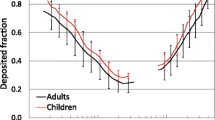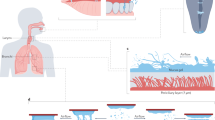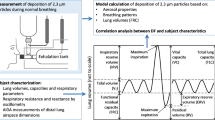Abstract
Calculations of the contribution of diffusion to lung retention given previously (W. Findeisen,Pflüg. Arch. f. d. ges. Physiol.,236, 367–379, 1935; H. D. Landahl,Bull. Math. Biophysics,12, 43–56, 1950) contained an error appreciably underestimating the role of diffusion for particles less than a few microns in diameter. In the calculations (Landahl, 1950), a schematic representation of the lungs was modified to conform to the actual resting lung volume by increasing the number of alveolar sacs. A recalculation of total deposition with this chematic model gives too large a retention for very small particles. Hence it seemed appropriate to recalculate the retention for various paricle sizes in various regions of the respiratory tract for several respiratory paterns, using the original schematic model but assuming that the estimates reflect conditions in a deflated lung. For a given tidal air the sizes of the alveolar ducts and sacs were assumed to expand so that the total volume of the model was equal to 2.5 liters plus one half of the tidal air, i.e., the mean lung volume. The results of these calculations are appreciably different from those given previously, but the differences are serious only for particles of about 0.1 micron or less. Also given is an approximation method for calculating the probability of impaction of droplets against nasal hairs.
Similar content being viewed by others
Literature
Einstein, A. 1905. “Über die von der molecularkinetischen Theorie der Wärme geforderte Bewegung von in ruhenden Flüssigkeiten suspendierten Teichen.”Ann. d. Physik,17, 549–560.
Findeisen, W. 1935. “Über das Absetzen kleiner, in der Luft suspendierten Teilchen in der menschlichen Lunge bei der Atmung.”Pflüg. Arch. f. d. ges. Physiol.,236, 367–379.
Landahl, H. D. 1950a. “On the Removal of Air-Borne Droplets from the Human Respiratory Tract: I. The Lung.”Bull. Math. Biophysics,12, 43–56.
— 1950b. “On the Removal of Air-Borne Droplets from the Human Respiratory Tract: II. The Nasal Passages.”Bull. Math. Biophysics,12, 161–169.
— 1953. “An Approximation Method for the Solution of Diffusion and Related Problems.”Bull. Math. Biophysics,15, 49–61.
Landahl, H. D., T. N. Tracewell, and W. H. Lassen. 1952. “Retention of Air-Borne Particulates in the Human Lung: III”A.M.A. Arch. Ind. Hyg. and Occupational Med.,6, 508–511.
Millikan, R. A. 1947.The electron (+and−), Protoms, Photons, Neutrons, Mesotrons and Cosmic Rays, Second Edition. Chicago: University of Chicago Press.
Author information
Authors and Affiliations
Rights and permissions
About this article
Cite this article
Landahl, H.D. Particle removal by the respiratory system note on the removal of airborne particulates by the human respiratory tract with particular reference to the role of diffusion. Bulletin of Mathematical Biophysics 25, 29–39 (1963). https://doi.org/10.1007/BF02477768
Received:
Issue Date:
DOI: https://doi.org/10.1007/BF02477768




